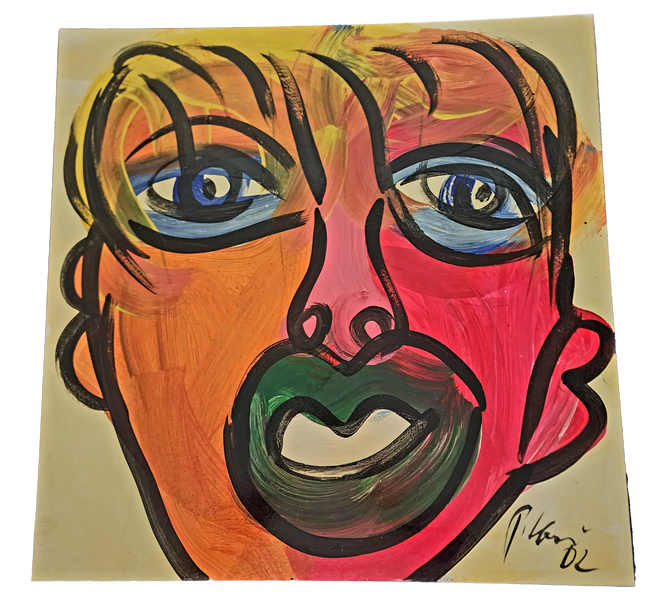
Oil Paint

Peter Keil Warhol 82 Large Face Original Oil Painting by Peter Keil
Warhol 82 Large Face Original Oil Painting by Peter Keil One of a Kind Artwork on Masonite Panel by The Wild Man of Berlin, a famous contemporary artist. 1982 Signed by Peter Keil & Dated Oil Painting on Masonite Panel Original Artwork Size 24x24. All of Peter Keil's Art Used Thick Paint & Some Paint Flaking May Be Present Due to the Age and Nature of His Work. Painting of Andy Warhol. Peter Keil's Warhol '82 Large Face: An Exemplar of Street Pop Art The original oil painting "Warhol '82 Large Face" by Peter Keil represents a profound intersection between the spontaneity of street art and the stylized sensibility of pop art. Crafted on a Masonite panel, this 24x24 artwork by the "Wild Man of Berlin" encapsulates the era's artistic vigor and pays homage to one of pop art's most iconic figures, Andy Warhol. Peter Keil, a luminary in the field, is known for his vibrant palette and vigorous brushwork, which are prominently displayed in this one-of-a-kind piece. Created in 1982 and bearing Keil's signature, the painting is a testament to his dynamic approach to portraiture and connection to contemporary art's larger narrative. The artwork's use of thick paint is a signature of Keil's style, offering a textured, almost sculptural quality to the image. While contributing to the piece's visual impact, this technique has also resulted in some paint flaking over time—a common characteristic of Keil's works from this period. The painting carries a sense of history and authenticity despite this, or perhaps because of it. It speaks not only to the longevity of Keil's art but also to the organic nature of street pop art, a genre that often embraces the beauty of imperfection and the passage of time. The Cultural Significance of Keil's Portrait of Warhol The cultural significance of Keil's portrait of Warhol cannot be overstated. By depicting Warhol, Keil aligns himself with a tradition of art deeply embedded in exploring celebrity culture, mass media, and consumerism. Warhol, a leading figure in the pop art movement, is an apt subject for Keil's expressive style, which is often characterized by a disregard for conventional beauty and a celebration of individualistic expression. The portrait is not just a likeness of Warhol but a dialogue with his legacy, rendered in the bold colors and sweeping lines that have become synonymous with Keil's oeuvre. Furthermore, the choice of Masonite as a substrate is particularly resonant within the context of Street Pop Art and Graffiti Artwork. As a material, Masonite bridges the gap between the traditional canvas and the urban landscape, bringing a sense of the street into the gallery. Sturdy and unpretentious qualities mirror the ethos of street art's accessibility and pop art's challenge to highbrow aesthetics. This artwork is a piece of cultural history, encapsulating the spirit of its time and the ongoing conversation between street culture and the art establishment. Legacy and Lasting Impact of Keil's Artistic Approach The legacy and lasting impact of Keil's artistic approach is evident in works like the "Warhol '82 Large Face." His method of employing thick layers of oil paint gives the artwork its distinctive texture and depth and connects it to the broader history of painting. Keil's work, much like graffiti, possesses an immediacy and an intensity that is amplified by the physicality of the paint itself. This physicality—combined with the cultural weight of his subjects—creates a compelling fusion that has influenced both street art and pop art. Keil's portrayals go beyond mere representation; they embody his subjects' spirits, capturing their essence through his frenetic brushstrokes and audacious use of color. The "Warhol '82 Large Face" is a perfect example of how Keil's work resonates with the vibrancy and the raw, emotional undercurrents of the urban experience. It is pieces like this that secure Peter Keil's place in the pantheon of artists who have successfully merged the worlds of street pop art and traditional painting, creating a visual language that is at once familiar and revolutionary. "Warhol '82 Large Face" by Peter Keil is a significant piece of art history and a vibrant narrative in the visual story of Street Pop Art and Graffiti Artwork. Its significance lies in its ability to communicate across time, bearing the marks of its creation and the vision of its creator. As a historical document, it offers insight into the aesthetic and thematic concerns of the early 1980s art scene. As a work of art, it stands as a powerful expression of identity, culture, and the enduring nature of visual communication.
$600.00


